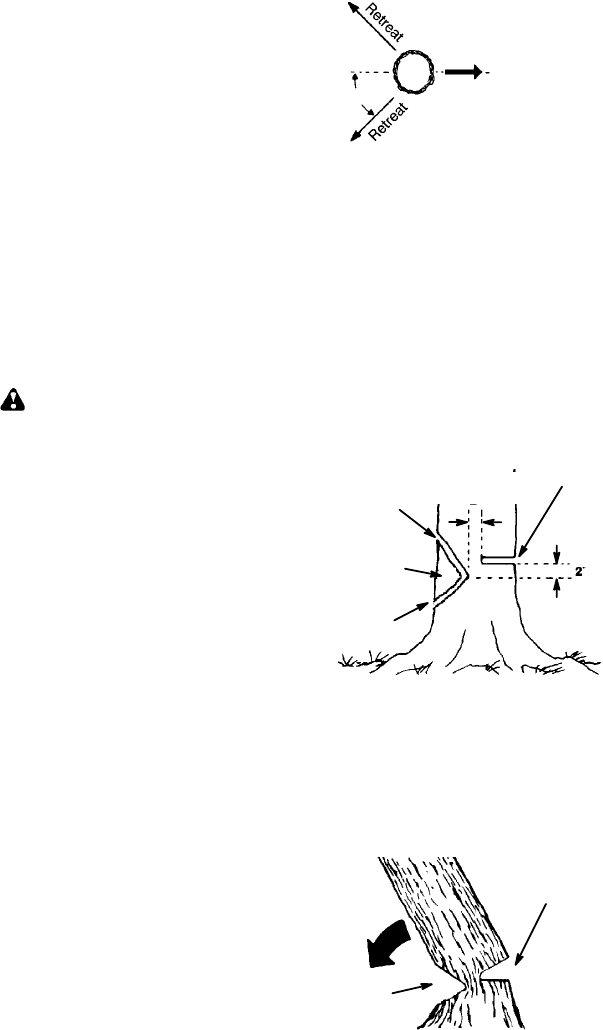
11
S Practicecutting afew smalllogs using the
followingtechniques togetthe“feel” ofus-
ing your saw before you begin a major
sawing operation.
S Squeeze the throttle trigger andallowthe
engine to reach full speed before cutting.
S Begin cutting w ith the saw frame
against the log.
S Keeptheengine atfullspeed theentire
time you are cutting.
S Allowthechaintocutforyou.Exertonly
light downward pressure. If you force
thecut,damagetothebar,chain,oren-
gine can result.
S Release the throttle trigger as soon as
the cut is completed, allowing the en-
gine to idle. If you run the saw at full
throttlewithoutacuttingload,unneces-
sary wear can occur to the chain, bar ,
and engine.
S Toavoidlosingcontrolwhencutiscom-
plete,d onotputpressureonsawatend
of cut.
S Stop the engine before setting the saw
down after cutting.
TREE FELLING TECHNIQUES
WARNING: Check for broken or
dead branches which can fall while cutting
causingserious injur y. Donotcutnearbuild-
ingsor electricalwiresifyoudonotknowthe
directionoftreefall,norcutatnightsinceyou
will not be ale to see well, nor during bad
weathersuchasrain, snow,orstrongwinds,
etc. Ifthetree makes contact w ithany utility
line, the utility company should be notified
immediately .
S Carefullyplanyoursawingoperationinad-
vance.
S Cleartheworkarea. Youneedacleararea
allaroundthetreesoyoucanhavesecure
footing.
S Study the natural conditions t hat can
cause the tree to fall in a particular direc-
tion.
Natural conditions that can cause a tree to
fall in a particular direction include:
S The wind direction and speed.
S The lean of the tree. The lean of a tree
might not be apparent due to uneven or
slopingterrain. Useaplum borleveltode-
termine the direction of tree lean.
S Weight and branches on one side.
S Surrounding trees and obstacles.
Look for decay and rot. If thetrunk isrotted,
it can snap and fall toward the operator.
Check for broken or dead branches which
can fall on you while cutting.
Make sure there i s enoughroomfor thetree
to fall. Maintain a distance of
2-1/2 tree
lengths fromthenearest personor otherob-
jects. Enginenoisecandrownoutawarning
call.
Remove dirt, stones, loose bark, nails, sta-
ples,andwirefromthetreewherecutsareto
be made.
Planaclearretreat pat hto therearanddiag-
onal to the line of fall.
Direction of Fall
45_
Plan a clear retreat path
FELLING LARGE TREES
(6 inches in diameter or larger)
The notch methodis used to f elllarge trees.
Anotchiscutonthesideofthetreeinthede-
sired direction of fall. After a felling cut is
made on the opposite side of tree, the tree
will tend to fall into the notch.
NOTE: If the tree has large buttress roots,
removethembeforemakingthenotch. Ifus-
ing saw toremove buttress roots, keep saw
chainfromcontactinggroundtopreventdull-
ing of the chain.
NOTCH CUT AND FELLING THE
TREE
S Make notch cut by cutting the top of the
notch first. Cut through
1/3 ofthediameter
ofthetree.Nextcompletethenotchbycut-
ting the bottom of the notch. See illustra-
tion. Once the notch is cut, remove the
notch of wood from the tree.
Notch
First cut
Second cut
Final cut here. 2inchesabove
center of notch.
S After removing the wood from the notch,
makethefellingcutontheopposite sideof
the notch. This is done by making a cut
abouttwo i n ches higherthan thecenterof
the notch. This will leave enough uncut
woodbetweenthefellingcutandthenotch
to form a hinge. This hinge will help pre-
ventthetreefromfallinginthewrongdirec-
tion.
Opening
of felling
cut
Closing of
notch
Hinge holds tree on stump and helps
control fall


















